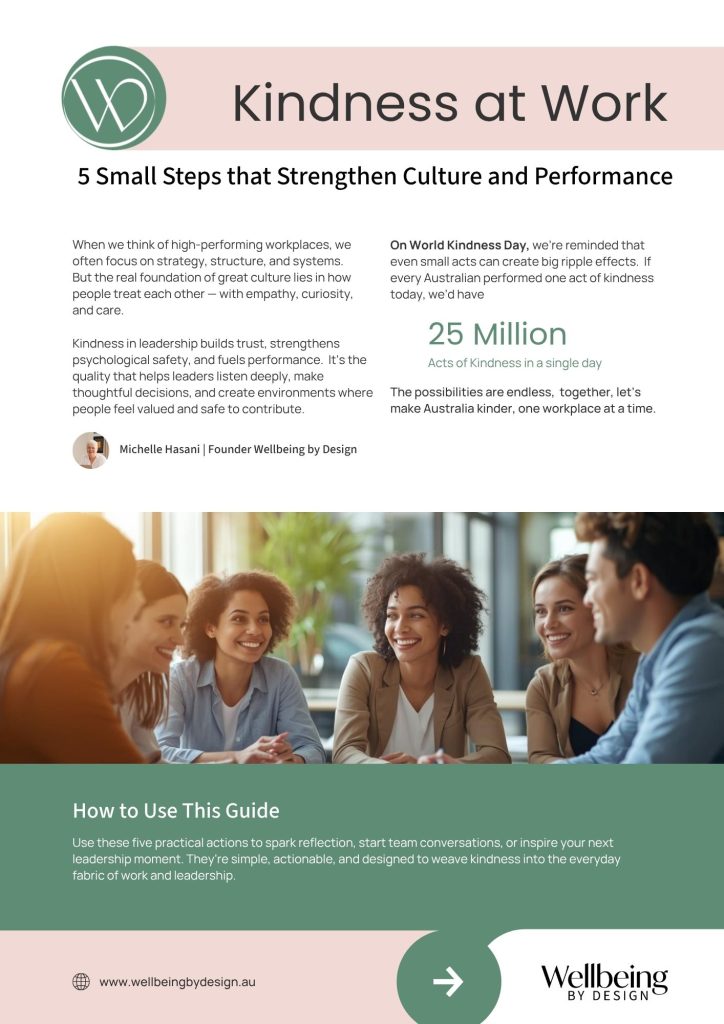In today’s fast-paced and often pressured work environment, leading with kindness isn’t just admirable. It’s strategic. Kindness leadership is a powerful catalyst for psychological safety, trust, and workplace wellbeing. When leaders create space for open dialogue and genuine empathy, people feel safe to share ideas, voice concerns, and show up as themselves.
The result? Greater creativity, stronger collaboration, and teams that thrive.
This World Kindness Day, we explore how compassionate leadership can transform culture from the inside out. Through everyday acts of empathy and conscious communication, leaders can build environments where people feel valued, supported, and empowered to do their best work.
Is kindness the missing link between wellbeing and results?
Why Kindness Leadership Matters
Kind leadership is more than a feel-good concept. It is a critical element in building a successful and resilient organisation. When leaders prioritise kindness, they foster an environment where trust, respect, and mutual understanding become the norm. This leadership approach enhances morale, strengthens retention, and directly improves performance.
Kind leaders listen actively, show genuine concern for their people, and recognise the human experience behind the work. They understand that leadership is not only about driving outcomes but also about creating the conditions for people to thrive. As a result, employees feel valued, motivated, and more willing to contribute their best efforts.
Kindness also breaks down barriers and fosters inclusivity. When leaders model respect and care, it signals to everyone that psychological safety is non-negotiable. This ripple effect encourages teams to treat each other with the same consideration, creating a culture where diverse thinking is welcomed and everyone feels they belong. The organisation benefits through deeper engagement, richer perspectives, and stronger innovation.
Psychological Safety in the Workplace – The Critical Ingredient
Psychological safety has become one of the most significant drivers of performance and culture. Harvard researcher Amy Edmondson defines psychological safety as “the belief that one will not be punished or humiliated for speaking up with ideas, questions, concerns, or mistakes, and that the team is safe for interpersonal risk-taking.”
In simple terms: It’s feeling safe to speak up, take risks, and ask for help without fear of judgement or blame.
When psychological safety is low:
- people hold back ideas
- leaders receive filtered or incomplete information
- mistakes are hidden rather than learned from
- performance becomes compliance, not contribution
- wellbeing erodes
In psychologically safe cultures:
- creativity and problem-solving increases
- collaboration deepens
- issues surface earlier
- communication is more open and honest,
- resilience grows

Creating psychological safety requires intentional leadership. It means celebrating diverse perspectives, responding constructively to challenges, and modelling the behaviours leaders want to see.
A workplace that prioritises psychological safety is more likely to retain employees, reduce absenteeism, and attract top talent.
The simplest behaviour that builds psychological safety?
Kindness.
The Science Behind Safety and Performanceeing as a Leadership Capability
Kindness has a measurable impact on the brain.
When people feel threatened or undervalued, cortisol, the stress hormone, spikes, narrowing focus and reducing the brain’s ability to solve problems. In contrast, small acts of kindness such as active listening, recognition, or genuine check-ins trigger oxytocin and dopamine. These “connection chemicals” boost trust, motivation, and emotional stability.
In mentally fit teams, where leaders respond with curiosity rather than urgency or judgement, people feel safer to think, participate, and contribute.
Kindness doesn’t just feel good. It optimises the brain for better work.
Wellbeing as a Leadership Capability
Wellbeing is no longer a benefit or a program. It is a leadership capability.
Leaders who build mental fitness, the ability to respond rather than react, model emotional intelligence and presence. Through calm communication and empathy, they create environments where people feel safe to contribute openly and take healthy risks.
When leaders demonstrate mentally fit behaviours, teams experience:
- clearer expectations
- more transparent communication
- healthier boundaries
- higher trust
- more consistent emotional tone
Kindness becomes cultural not through slogans or values statements, but through the small, everyday actions leaders take.
Feedback Without Fear
Kindness does not mean lowering expectations. It means delivering clarity with care.
When leaders communicate with respect and intention, feedback becomes a tool for growth rather than criticism. People feel ready to engage, ask questions, and take ownership. They approach difficult conversations with curiosity instead of defensiveness.
As I often remind leaders:
“When leaders model kindness, they give their teams permission to exhale. It becomes easier to speak up, make mistakes, and collaborate. Kindness isn’t the opposite of accountability. It’s the foundation that makes accountability possible.”
Accountability grounded in kindness builds trust, not fear. It enables honesty. It strengthens culture. And it creates the conditions where growth becomes normal rather than risky.
Innovation Through Belonging
Creativity does not emerge in environments of fear. It emerges when people feel they belong.
When psychological safety is high:
- people challenge assumptions
- they share bold ideas
- they take healthy risks
- they problems solve more openly
- they collaborate with greater ease

Think of your workplace as a garden: Psychological safety is the soil. Kindness is the sunlight. Without both, even the best talent struggles to grow. With them, innovation becomes natural.
Global Examples of Kind Leadership in Action
Across industries, many organisations are demonstrating how kindness and psychological safety can transform culture, strengthen wellbeing, and improve performance.
These organisations demonstrate the power of kindness in leadership at scale:
Johnson & Johnson
Johnson & Johnson leads with care through its long-standing Credo, which prioritises people and community. This values-driven approach fosters a supportive culture and strengthens employee wellbeing.
Patagonia
Patagonia’s empathy-led, flexible, family-friendly culture fosters loyalty and purpose. Their commitment to transparency and care is central to their leadership identity.
Google
Through Project Aristotle, Google identified psychological safety as the key driver of great teams. Leaders intentionally create environments where people feel safe to speak up, take risks, and innovate.
Small Steps to Start Today
Creating a kinder culture does not require sweeping change.
It starts with intentional moments.
Try simple kindness activity’s:
- beginning meetings with one genuine appreciation
- replacing “Who is responsible?” with “What can we learn from this?”
- checking in with people beyond performance metrics
- acknowledging effort, not only outcomes
- pausing to listen fully before responding
- offering clarity, during uncertainty
- responding early when signs of strain appear
Small steps. Big ripple effects.
Kindness becomes self-reinforcing when leaders model it consistently.
Measure Your Progress
Understanding psychological safety in your organisation requires looking beyond metrics. Surveys provide insight, but the richest data comes from the conversations underneath — the stories, emotions, and everyday experiences that shape culture.
Focus groups and interviews help leaders uncover what drives the numbers, revealing how safe people truly feel to speak up, contribute, and take risks.
The Future of Workplace Wellbeing Through Kind Leadership
The future of work belongs to organisations that recognise kindness as a leadership advantage. When kindness becomes part of how people lead, psychological safety deepens, wellbeing strengthens, and performance becomes more sustainable.
This World Kindness Day, we celebrate the power of kind leadership and its impact on workplace wellbeing.
Kindness is not a feel-good extra.
It is a cultural catalyst.
It helps people thrive — and organisations thrive with them.
Free Resource: Kindness at Work – 5 Small Steps That Strengthen Culture & Performance

If you’d like a simple way to begin, download the free guide:
Kindness at Work – 5 Small Steps That Strengthen Culture & Performance.
You’ll find practical actions leaders can use immediately to spark connection, trust, and collaboration across teams.
Ready to Take the Next Step?
Explore how our coaching helps leaders embed wellbeing, strengthen psychological safety, and build thriving teams.







